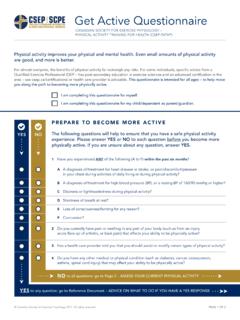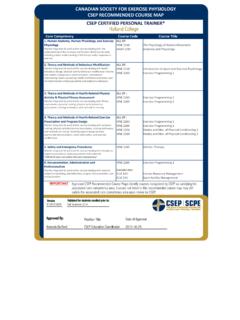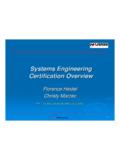Transcription of CSEP-CPT Health Screening Tool for Clients with One ...
1 CSEP-CPT Health Screening tool for Clients with One medical Condition A CSEP-CPT can work with Clients who have one diagnosed medical condition that is stable or determined to be at a lower risk for an adverse event during exercise. This generally is considered to mean: i) medical condition is being medically managed and client is asymptomatic; ii) no change in medication or treatment plan in the past 6. months; and iii) if physician has prescribed a medication, it is being taken as directed. If your client identifies that he/she has a medical condition, the following Health Screening tool can be used in addition to the Get Active Questionnaire. The purpose of this tool is to determine whether your client's medical condition would be considered lower risk according to available research. NOTE: the list of medical conditions described in the tool is not comprehensive; rather, only the more common medical conditions diagnosed amongst the Canadian population have been included.
2 A CSEP-CPT who is interested in other examples of lower risk medical conditions should take an appropriate continuing education course. FOR Clients with A medical CONDITION. Place a check mark ( ) beside any statement that is true. If your client has asthma1 : Client experiences chest tightness, wheeze, shortness of breath, or cough on >2 days/week OR >1 night/week Client has used rescue medication >2 times in last week If your client has heart disease2,3: Client has not completed a supervised cardiac rehabilitation program Client has experienced cardiac symptoms during cardiac rehabilitation program and/or in last six months Client has diagnosed or suspected: aneurysm, valve disease, angina (any kind), acute myocardial infarction, inflammatory diseases of heart ( , myocarditis, pericarditis, etc.), arrhythmia, heart failure If your client has hypertension2: Client has a resting BP >160/90mmHg (one or both values; measure resting BP to confirm). If your client has osteoarthritis4: Client experiences joint pain, severe stiffness or swelling >14 days (particularly in back, hip, knees, feet and spine).
3 Client has limited mobility in any activities due to joint damage If your client has osteoporosis4,5: Client had a fragility fracture (fracture as a result of minimal trauma) after age 40 years Client has taken systemic corticosteroids for a cumulative period of >3 months at a prednisone-equivalent dose of > daily Client has had a recent fall or >2 falls in past 12 months If your client has type 2 diabetes6,7: Client has a diabetic complication such as issues affecting eyes, kidneys OR the sensation in toes/feet OR has been diagnosed with coronary heart disease Client experiences shakiness, confusion, lightheadedness, etc. due to hypoglycemia Client is interested in doing vigorous exercise Any statement checked above? REFER client first to an appropriate Health care provider for clearance. Or recommend client get exercise advice from a CSEP-CEP. CSEP-CPT Health Screening tool for Clients with medical conditions (Sept 20, 2017) v2. Page 1 of 2. Overview of the CSEP-CPT Screening process for Clients with medical conditions (All of the situations below are based on the assumption that resting HR and resting BP have been measured and are below established thresholds).
4 Client does not Client does regular*. perform regular*. physical activity physical activity Clients can begin Client does not have any PROCEED to STEP 2 ASSESS Clients should with level of suspected or known as outlined in the CSEP-PATH begin with light to physical activity that medical conditions Manual moderate physical they are currently activity**. doing**. Client has one medical Gradually progress PROCEED to STEP 2 ASSESS Progress as condition and no check as tolerated as outlined in the CSEP-PATH appropriate mark(s) in the additional following CSEP- Manual following CSEP- Screening tool . PATH guidelines**. PATH guidelines**. Client has one medical REFER client to an appropriate condition and 1+ check Health care provider for clearance mark(s) in the CSEP-CPT or refer client to a CSEP-CEP for Health Screening tool exercise advice. If clearance provided for unrestricted physical CHECK: Do you have the activity, PROCEED to STEP 2 ASSESS as knowledge, skills and abilities to outlined in the CSEP-PATH Manual conduct thorough prescreening Client has one medical and provide exercise advice for Use recommendations above for exercise condition that is not listed in that medical condition?
5 If not, prescription the CSEP-CPT Health recommend client obtain clearance Screening tool . from an appropriate Health care provider or refer client to a CSEP- CEP for exercise advice. Client has more than one REFER client to a CSEP-CEP for medical condition exercise advice. * Regular physical activity is defined as at least 150 minutes per week of moderate intensity activity for past 3 months ** Clients with a medical condition interested in doing vigorous physical activity should be referred to a CSEP-CEP or obtain clearance from a physician. REFERENCES: 1. Eves N. Davidson W. Evidence-based risk assessment and recommendations for physical activity clearance: Respiratory disease (2011). Appl Physiol Nutr Metab, , 36(S1): S80-S100, 2. Thomas SG, Goodman JM, Burr JF (2011). Evidence-based risk assessment and recommendations for physical activity clearance: established cardiovascular disease. Appl Physiol Nutr Metab, 36(S1): S190-S213, 3 th ACSM. Guidelines for Exercise Testing and Prescription (10 ed).
6 Wolters Kluwer. 4. Chilibeck PC, Vatanparast H, Cornish SM, Abeysekara S, Charlesworth S (2011). Evidence-based risk assessment and recommendations for physical activity: arthritis, osteoporosis, and low back pain. Appl Physiol Nutr Metab. 36(S1): S49-S79, 5. Papaioannou, A., Morin, S., Cheung, A. M., Atkinson, S., Brown, J. P., Feldman, S., et al. (2010). 2010 clinical practice guidelines for the diagnosis and management of osteoporosis in Canada: Summary. Canadian medical Association Journal. 182(17): 1864-1873.. 6. Riddell MC, Burr J. Evidence-based risk assessment and recommendations for physical activity clearance: diabetes mellitus and related comorbidities. Applied Physiology, Nutrition, and Metabolism, 2011, 36(S1): S154-S189, 7. Armstrong MJ. Sigal RJ. Physical activity clinical practice guidelines: what's new in 2013? (2013). Canadian Diabetes Journal. 37(6), 363 366. CSEP-CPT Health Screening tool for Clients with medical conditions (Sept 20, 2017) v2.
7 Page 2 of 2.









